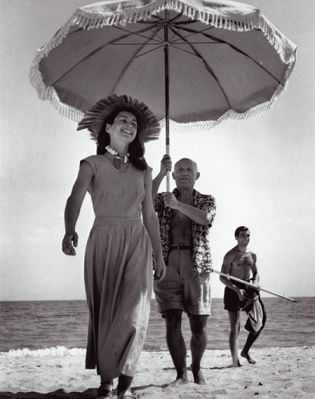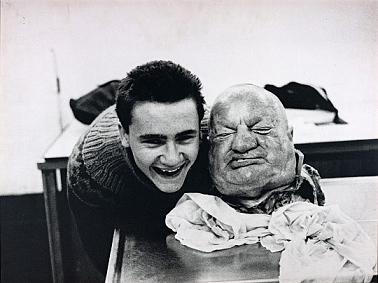
"Art stars are different from artists because they supply personae to their public." So writes Elizabeth Currid-Halkett in her new book, Starstruck: The Business of Celebrity. Currid-Halkett names Jeff Koons, Damien Hirst, and Tracey Emin as today's art stars, and identifies Picasso and Duchamp as their predecessors: all made their personalities inseparable from their art. Thus Picasso's many love affairs became as much a part of his public image as Damien Hirst's "art yobbo" boorishness has become a part of his.

Françoise Gilot and Picasso, with Fin Vilato, Robert Capa, 1948, © International Center of Photography/Magnum Photos

With Dead Head, Damien Hirst, 1981-1991, National Galleries of Scotland
Since the Renaissance, important artists have often been accorded great respect by their patrons: so for example Pope Julius II was willing to meet Michelangelo "as an equal" in order to gain his agreement to paint the ceiling of the Sistine Chapel, and when Prince Cosimo, the future Archduke of Tuscany, traveled to Amsterdam in 1667, the logbook of his journey recorded his visit to the studio of "Rembrandt the famous painter." Yet it is only in the modern era that living artists have gained fame among a much wider public. As the audience for art expanded in modern times, some artists became genuine celebrities, and new forms of artistic behavior became possible. As in so many other areas, Picasso was an innovator: Arianna Huffington observed that he "mastered the publicity game before the world knew such a game existed." His mastery was such that John Berger opened his 1965 biography with the declaration that "Picasso is now wealthier and more famous than any other artist who has ever lived."
Painters are not the only artists who have deliberately constructed public images that have complemented their art. Harold Bloom surveyed the activities of Ernest Hemingway, from his many marriages and numerous stints as a war correspondent to his big-game hunting and fishing, and noted that they constituted "an absurdly implausible life, apparently lived in imitation of Hemingway's own fiction." Bloom contended that the persona magnified Hemingway's achievement: "Faulkner, Stevens, Frost, perhaps Eliot, and Hart Crane were stronger writers than Hemingway, but he alone in this American century has achieved the enduring status of myth."

Game Hunter, Earl Theisen, 1954, National Portrait Gallery, Washington D.C.
What Picasso, Duchamp, Hemingway, Koons, Hirst, and Emin have in common is that they are all conceptual artists, whose work is not intended as objective or realistic description, but instead as an expression of their own ideas and feelings. During the past century, conceptual artists have devised many novel practices and behaviors that have been carefully designed to increase the reach and impact of their art. Making their own persona one of their most important creations is a major innovation of the modern era, as is adopting the attitude toward publicity that welcomes all commentary: as Currid-Halkett quotes Andy Warhol, one of the greatest masters at creating artistic celebrity, "Don't pay any attention to what they write about you, just measure it in inches."
